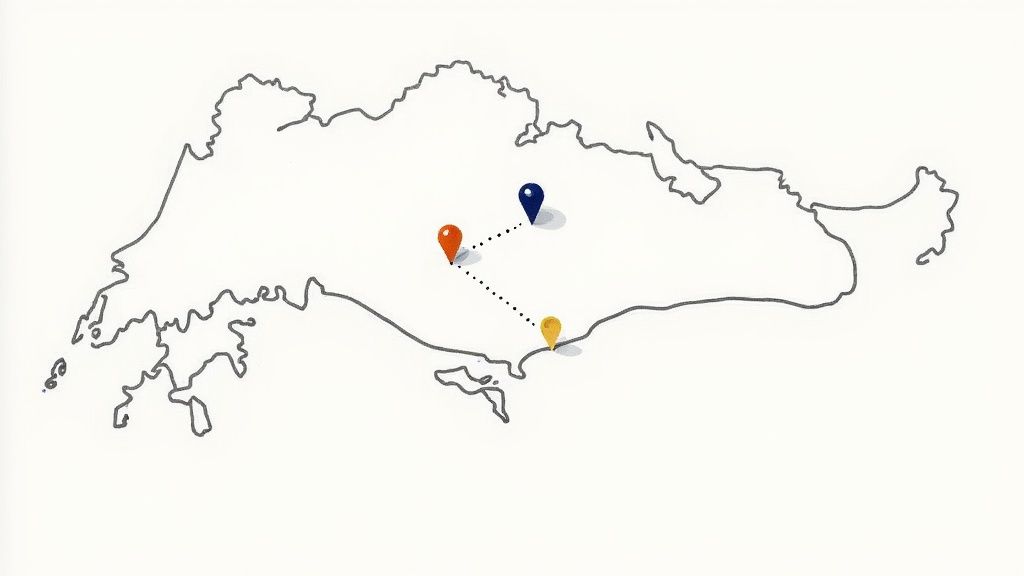Is Spanish Easy to Learn for English Speakers?
So, let's get right to it. You’ve probably heard that Spanish is one of the easiest languages for English speakers to pick up. And there's a lot of truth to that, but easy doesn't mean effortless. The reputation for being "easy" comes from some pretty solid advantages: a shared alphabet, sounds that are a breeze to pronounce, and thousands of words that look and mean almost the same thing in English. These are your quick wins.
Setting Realistic Expectations for Learning Spanish
For a native English speaker, is Spanish genuinely easy to learn? The short answer is a qualified yes. The U.S. Foreign Service Institute (FSI), which trains diplomats, classifies Spanish as a Category I language. This means it's considered one of the fastest languages for English speakers to get a handle on, estimating it takes about 600 hours of dedicated study to reach professional fluency. That puts it in good company with other Romance languages like French and Italian.
Think of your Spanish learning journey less like scaling a sheer cliff and more like walking up a long, steady hill. You’re not starting from scratch. The alphabet is almost identical, which is a huge head start. Plus, Spanish is beautifully phonetic—words are almost always pronounced exactly how they're spelt. This consistency is a massive relief compared to the unpredictable pronunciation puzzles found in languages like English or French.
But let's be real, "easy" is a relative term. The early days of learning Spanish can feel surprisingly smooth, but hitting true fluency means getting your head around some grammatical concepts that just don't exist in English.
What's Easy and What's Tricky?
To give you a clearer picture, here's a quick breakdown of what you'll face.
Spanish Learning Quick Overview for English Speakers
| Language Aspect | Why It's Considered Easy | Potential Challenges |
|---|---|---|
| Alphabet & Pronunciation | Uses the familiar Latin alphabet. Sounds are consistent and phonetic. | The rolled 'rr' and the soft 'g'/'j' sounds can take practice. |
| Vocabulary | Thousands of cognates (similar words) like información and animal. |
"False friends" exist—words that look similar but have different meanings. |
| Grammar Foundation | Sentence structure (Subject-Verb-Object) is often similar to English. | Verb conjugations, noun genders, and the subjunctive mood require a new way of thinking. |
| Resources | Huge availability of music, films, books, and learning apps. | The sheer volume can be overwhelming; finding a structured path is key. |
As you can see, the path is paved with familiar stepping stones, but there are some new concepts to master.
The Big Hurdles to Watch Out For
While you'll be celebrating those vocabulary wins early on, there are a few key areas that tend to trip up English speakers. Getting ready for them now will save you a lot of frustration later.
- Verb Conjugations: In Spanish, verbs change their endings depending on who is doing the action and when. This is a much bigger deal than in English, where we mostly just add an "-s" for he/she/it.
- Noun Genders: Every single noun is either masculine or feminine. A table is
la mesa(feminine) and a book isel libro(masculine). It’s a matter of memorisation and getting a feel for it over time. - The Subjunctive Mood: This is the big one. It's a whole set of verb forms used to talk about desires, doubts, and hypotheticals. It doesn't have a direct equivalent in English and is often the final boss for intermediate learners.
As you think about starting your journey, it's a great idea to explore the best apps for language learning to find tools that fit your style.
Ultimately, your success will come down to having realistic expectations. You'll fly through parts of it, feeling like a natural. In other areas, you'll need to dig in and be patient. It’s a journey of using familiar building blocks to construct something entirely new.
Why Your English Gives You a Head Start in Spanish
If you’re coming from an English-speaking background, you’re in luck. You aren't starting your Spanish journey from zero. You've actually got a solid toolkit that gives you a real leg up.
Think of it this way: you’re not building a house from the ground up. Instead, you're renovating a property where the foundation and main structure are already solid. Your job is to work with what's already there.
Your biggest advantage? Cognates. These are words in English and Spanish that share a common origin, making them look, sound, and mean almost the same thing.
Both languages have deep roots in Latin, which means you already know thousands of Spanish words without even realising it. This isn't just a minor perk; it's a massive vocabulary boost right from the get-go.
Unlocking Vocabulary with Pattern Recognition
Spotting these cognates feels like cracking a secret code. Once you get the hang of a few simple patterns, you can instantly recognise a huge chunk of Spanish vocabulary. It’s incredibly rewarding in the early stages and really helps you build momentum.
Here are some of the most common patterns to watch for:
- English words ending in -tion often become -ción in Spanish. Think nation becoming nación, or information turning into información.
- Words ending in -ous frequently switch to -oso. So, famous is famoso, and delicious is delicioso.
- The -al ending is often a direct match. Animal stays animal, and hospital is still hospital.
- English words ending in -ent or -ant are usually the same or very similar. Different becomes diferente, and important is importante.
By mastering just a handful of these cognate patterns, you can unlock an estimated 3,000 to 5,000 Spanish words. This linguistic overlap gives you a huge confidence boost and fast-tracks your ability to read and understand basic texts.
Of course, you have to watch out for "false friends"—words that look alike but have totally different meanings. A classic example is embarazada, which means pregnant, not embarrassed! But honestly, these tricky exceptions are rare compared to the thousands of true cognates that give you a direct pathway into the language.
A Familiar Sentence Structure
Beyond the shared vocabulary, English and Spanish also share a fundamental sentence structure, which makes putting thoughts together feel surprisingly intuitive. Both languages generally follow the Subject-Verb-Object (SVO) word order.
Let's look at a simple English sentence: "The cat eats fish."
- Subject: The cat
- Verb: eats
- Object: fish
In Spanish, it lines up perfectly: "El gato come pescado."
- Subject: El gato
- Verb: come
- Object: pescado
This shared logic means you can start building basic, coherent sentences almost right away. Sure, Spanish grammar has its own complexities, like verb conjugations and grammatical gender, but this foundational similarity gives you a familiar framework to build on. Your English knowledge isn't just a little helpful—it's a powerful springboard that makes the answer to "is Spanish easy to learn?" lean heavily towards "yes."
Navigating Spanish Grammar: The Smooth and the Steep
Grammar is often the part of language learning that people dread the most. It sounds like a big, scary mountain you have to climb. But when it comes to Spanish, the terrain is actually quite varied. You'll find plenty of smooth, easy paths before you hit any of the really steep bits.
For anyone coming from English, a lot of Spanish grammar feels surprisingly logical. It’s a bit like putting together flat-pack furniture. Some steps are dead simple—screw A goes into hole A. Other parts make you double-check the instructions. The great thing about Spanish is that its instruction manual is incredibly clear, with far fewer of the weird exceptions you find all over English.
The Gentle Slopes: Noun Genders and Adjective Agreement
One of the first new ideas you'll bump into is grammatical gender. In Spanish, every single noun is either masculine or feminine. It’s not about the object itself, but just a grammatical category. For instance, el libro (the book) is masculine, while la mesa (the table) is feminine.
At first, this might seem completely random. Why is a book a "he" and a table a "she"? But you quickly start seeing patterns. A huge number of nouns ending in -o are masculine, and most that end in -a are feminine. That simple rule gives you a head start on thousands of words, making this whole gender thing feel a lot less intimidating.
From there, you have adjective agreement. This just means that adjectives have to match the noun they’re describing in both gender and number. So, a red book is el libro rojo, but a red table is la mesa roja. It’s an extra step, for sure, but it’s a consistent one. It actually helps reinforce the gender system until it becomes second nature. It's less about painful memorisation and more about getting into a logical rhythm.
This infographic breaks down how Spanish grammar is built on these kinds of predictable rules, from noun gender to verb patterns.
The visual shows that the core of the language follows a really logical structure, which is a big reason why the answer to "is Spanish easy to learn?" is often a resounding yes.
To give you a clearer picture, let's compare some key grammatical features side-by-side.
Spanish vs English Grammar Comparison
| Grammatical Feature | How It Works in English | How It Works in Spanish |
|---|---|---|
| Noun Gender | Nouns are neutral (e.g., "the table," "the car"). | All nouns are either masculine (el libro) or feminine (la mesa). |
| Adjective Agreement | Adjectives don't change (e.g., "a red car," "two red cars"). | Adjectives must match the noun's gender and number (el coche rojo, la casa roja, los coches rojos). |
| Verb Conjugation | Verbs change very little ("I talk," "you talk," "she talks"). | Verbs change for every subject pronoun (yo habl*o,* tú habl*as,* él habla). |
| Subject Pronouns | Usually required ("I am happy"). | Often dropped because the verb ending already shows who is speaking (Estoy feliz). |
| Sentence Structure | Follows a strict Subject-Verb-Object order. | More flexible; word order can be changed for emphasis. |
This table shows where you'll find familiar ground and where you'll need to learn a new way of thinking. Now, let's talk about one of those new ways.
The Steeper Climbs: Verb Conjugations and The Subjunctive
Alright, now for the part of the climb that requires a bit more effort: verb conjugations. In English, our verbs are pretty lazy. "I talk," "you talk," "we talk"—they barely change. Spanish verbs, on the other hand, change their endings for every single subject.
Take the verb hablar (to speak). It changes like this:
- Yo hablo (I speak)
- Tú hablas (You speak)
- Él/Ella habla (He/She speaks)
This system can look like a nightmare at first glance, but it's incredibly regular. Once you learn the patterns for the three main verb types (-ar, -er, and -ir), you suddenly know how to conjugate thousands of them. Think of the endings as different attachments for a power tool—each one has a specific job and clicks perfectly onto the verb stem.
If there's a "final boss" in Spanish grammar, it’s the subjunctive mood. This is a whole different set of verb forms used for talking about desires, doubts, possibilities, and anything that isn't a concrete fact. Modern English doesn't really have a direct equivalent, so it’s a brand-new concept for most learners.
Getting the hang of the subjunctive is what really separates intermediate speakers from advanced ones. It takes time, practice, and a lot of exposure to authentic Spanish to develop an instinct for it. But here’s the thing: you can communicate perfectly well for a long time without ever mastering it. It’s a hurdle, but it's one you tackle way down the road, long after you've built a solid foundation on the much smoother, more predictable parts of Spanish grammar.
How to Master Spanish Pronunciation
One of the best parts about learning Spanish is how quickly you can start sounding like you know what you’re doing. English is notorious for its chaotic spelling—just think about "though," "through," and "tough"—but Spanish is a breath of fresh air. It’s almost perfectly phonetic, meaning words are pronounced just how they’re spelt. This is a huge leg-up for beginners.
This consistency is your greatest asset. If you can learn just a handful of straightforward rules, you’ll be able to pronounce nearly any Spanish word you come across. The entire system is built on five pure, unchanging vowel sounds.
- A is always like the 'a' in "father"
- E is always like the 'e' in "bed"
- I is always like the 'ee' in "see"
- O is always like the 'o' in "go"
- U is always like the 'oo' in "moon"
Nail these five sounds, and you’re already halfway to speaking with clarity. It’s this very simplicity that often makes the answer to "is spanish easy to learn?" a resounding "yes," because you can build real speaking confidence right from the get-go.
Tackling the Tricky Sounds
While most Spanish sounds will feel familiar, there are a few that need a bit more practice. These are the sounds that, once you get them right, will really make your accent shine. The goal isn't perfection from day one, but steady, consistent practice.
The most famous of these is the rolled 'rr', which you hear in words like perro (dog) or carro (car). A good way to think of it is like a cat purring. To get the feel for it, place the tip of your tongue on the roof of your mouth, just behind your teeth, and let it vibrate as you breathe out.
Then there’s the soft 'd' sound, which pops up between vowels in words like lado (side). It’s not the hard, abrupt 'd' from "dog," but a much gentler sound, almost like the 'th' in "this." It’s a subtle shift, but it makes a world of difference in sounding more fluent.
The secret to mastering these new sounds isn’t endless, boring drills. It's about listening and imitating. Put on a Spanish movie or song, pay close attention to how native speakers shape these words, and try to copy them. This kind of active listening beats reading rules any day.
Lastly, we have the letter 'ñ', like in the word español. It creates a "nyah" sound, a lot like the 'ni' in "onion." It's a unique sound that's actually quite easy to get used to. You’ll even find it when learning to sing "happy birthday in Spanish" at your next fiesta! A little focus on these key sounds will have you speaking clearly and confidently in no time.
The Unique Learning Landscape in Singapore
Learning a new language is always an adventure, but where you are in the world definitely shapes the journey. For anyone in Singapore asking, "is Spanish easy to learn?", the answer is a mix of local challenges and unique advantages.
Let's be realistic: you won't overhear Spanish conversations at a kopitiam or on the MRT. Unlike someone living in Spain or Latin America, daily immersion isn't a given here, which means you have to get creative and build it yourself.
This can sometimes make progress feel slower. Singapore's educational focus is, quite rightly, on English and our designated Mother Tongue languages—Mandarin, Malay, or Tamil. Spanish simply isn't part of the standard school curriculum. While interest is definitely on the rise, official figures show it’s not a major language spoken at home. In fact, 48.3% of residents use English most often. You can dig deeper into the numbers by checking out Singapore's linguistic diversity in the latest census data.
Because of this, a proactive mindset is non-negotiable. You’ll have to actively hunt down opportunities to speak and listen, whether that's through a structured class, a language exchange app, or by joining cultural events.
Leveraging Your Singaporean Advantage
But here’s the flip side—and it's a big one. Learners in Singapore often have a powerful, and frequently overlooked, superpower: a bilingual brain.
Growing up navigating at least two languages builds incredible "language-learning muscles." Your mind is already wired to juggle different grammars, vocabularies, and sounds, making it far more flexible when a new language like Spanish comes along. This is a real, tangible edge.
The disciplined and structured approach baked into the Singaporean education system is another huge plus. You're likely already used to organised study and the routine of consistent practice, which are the absolute bedrock of mastering any language.
Instead of seeing the lack of daily immersion as a drawback, think of it as a call to build your own system. It pushes you to be more deliberate and efficient with your learning—a skill that’s valuable far beyond just Spanish.
Ultimately, the Singaporean context transforms learning Spanish into a focused project. You already have the cognitive tools from your bilingual background and the discipline to stick to a plan. By combining these strengths with the right resources, you can build your own Spanish bubble right here in the Lion City, turning a potential hurdle into your greatest advantage.
Finding Your Spanish Community in the Lion City
Let's be honest: you're not going to stumble into Spanish conversations while ordering your kopi O in Singapore. But that doesn't mean you're on your own. For the motivated learner, the city offers a unique opportunity. It’s not about finding immersion, but about creating it.
Success here means being deliberate. You have to be proactive, turning the city into your own personal language lab. It's about shifting your focus from the classroom to real-world connections, finding the people and places that make the language breathe. This changes the question from "is Spanish easy to learn" into a practical mission: how do I build my community?
Building Your Immersion Bubble
Your first step is finding your tribe—other people on the same learning adventure. While Spanish is still a niche interest here, there’s a small but incredibly passionate community waiting to be discovered. Organisations like the Spanish Council of Singapore are excellent starting points, acting as hubs for classes and connecting you with a network of fellow learners and native speakers.
You can feel the interest in Spanish growing locally, likely because it’s a global powerhouse spoken by almost 483 million native speakers. Learners in Singapore are usually very self-motivated, studying for work or personal passion, which makes for a wonderfully focused and supportive community.
Creating an immersion bubble is less about location and more about mindset. It's about actively seeking out every opportunity to listen, speak, and live the language, even if it's just for a few hours each week.
Actionable Steps to Find Your Community
Beyond formal classes, there are plenty of ways to weave Spanish into your daily life in Singapore. The real goal is to make speaking and listening a regular habit, not just a weekly chore.
Here are a few practical strategies to get you started:
- Language Exchange Apps: Download apps like Tandem or HelloTalk. They're brilliant for connecting with native Spanish speakers who want to practise their English. Before you know it, you’ll have partners for text, voice, or even video chats.
- Cultural Events: Keep an eye on what the local embassies and cultural centres are up to. Film festivals, art exhibitions, and cultural celebrations are fantastic for hearing authentic Spanish and meeting people with similar interests.
- Online Communities: Jump into Facebook groups or forums for Spanish learners in Singapore. These are goldmines for sharing resources, organising informal meetups, and getting answers to simple questions, like how to properly ask "how are you in Spanish".
Finding a group is one thing, but actively using collaborative learning strategies with them will make all the difference, speeding up your progress and making the whole journey far more enjoyable.
Got Questions About Learning Spanish? We Have Answers
So, you’re thinking about learning Spanish. It’s natural to have a few questions before you dive in. What kind of time commitment are you looking at? Will it help your career here in Singapore? Let's get straight to the answers for the most common questions we hear from people just like you.
We'll break down everything from realistic timelines to job prospects, giving you the clear picture you need to decide if Spanish is the right fit for you.
How Long Does It Take to Actually Speak Spanish?
Let's talk about reaching that sweet spot: being conversational. We're talking about handling everyday chats with confidence—ordering food, asking for directions, talking about your day. For most English speakers, getting to this level takes around 500-600 hours of dedicated learning.
Now, what does that look like in real life for someone in Singapore with a job or school to juggle? Realistically, you're looking at 1.5 to 2 years of steady effort.
The real secret isn't locking yourself away for hours on a Saturday. Progress comes from making Spanish a small part of your daily life. Even 20-30 minutes a day, done consistently, will get you much further than a frantic weekend cram session.
Think of it like training for a marathon, not a 100-metre sprint. The goal is steady, sustainable progress. Small, daily wins build real, lasting fluency and keep you from burning out.
Will Knowing Spanish Help Me Find a Job in Singapore?
Spanish is a massive global language, but let's be upfront about the job scene in Singapore. It's more of a niche skill than a core requirement for most jobs here.
You'll find roles where Spanish is a plus—especially in international business, finance, or tourism—but they aren't as common as jobs looking for Mandarin or Japanese speakers. The best way to see it is as a unique advantage. It’s a skill that makes your CV pop, especially for roles in multinational companies or positions that interact with global markets. It sets you apart from the crowd.
Is Spanish Easier to Learn Than French?
For an English speaker, the short answer is almost always yes. The biggest hurdle in any language is often pronunciation, and this is where Spanish shines.
Spanish is almost perfectly phonetic, meaning you say it just how it’s written. This is a huge confidence booster for beginners, letting you start speaking and being understood right away. You get to sidestep the headaches of French, with its silent letters and tricky vowel sounds that can trip up even seasoned learners.
Both are Romance languages and share some grammatical DNA, but the clear, consistent pronunciation of Spanish makes for a much friendlier start.
Ready to start your journey with a language that opens up a world of culture and connection? At Spanish Council Singapore, our native teachers create an engaging and effective learning environment to help you achieve your goals. Explore our courses for adults, teens, and kids today
















